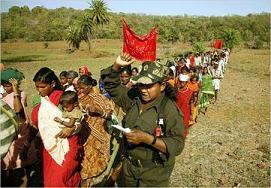The Maoist Insurgency in India

The Indian government is puzzled by one fundamental problem that has become desperate to its own security. With its officials eyeing Pakistan and the funnelling of terrorism through its borders, and the concern with international jihadi movements, it has ignored its own, Maoist grown revolt. Anywhere up to 6,000 people have perished in the Naxalite insurgency of the last 20 years, and the Indian Prime Minister Manmohan Singh has decided to place the Maoist movement’s threat to Indian security at the forefront of public and official debate.
Near the end of 2009, the central Indian government began implanting forceful measures to combat the Naxals, who now have a presence in 180 of Indians 626 districts (Guardian, Dec 6, 2009). The establishment of this Red Corridor is certainly a far cry from the origins of the movement, which sprouted from the Naxalbari area of West Bengal in 1967. Then, they were a motley crew, discordant and incoherent, susceptible to internal vendettas and feuds. With a marriage of Marxist-Leninist ideology and Maoist tactics, the movement staggered and stuttered through near annihilation to emerge as a highly dangerous force.
In December, government forces commenced operations with Operation Green Hunt, a military engagement with little fuss and even less activity. The rebels, reports suggested, had simply melted into the jungles. The military solution is now all some officials can talk about. The logic of force, rather than the force of logic, prevail in these circles.
Union Home Minister P. Chidambaram has insisted that the Maoist ultras will be crushed. His most recent comments, quoted in the Indian press, suggest that he has little time for their revolutionary antics. The Naxals were ‘cowards enacting dramas’, lethal thespians who went about the business less of protecting the poor than destroying schools, railway lines and vital infrastructure links. ‘If they have courage they should take part in democratic processes and face elections. Who is stopping them from winning elections?’ (Indian Express, Apr 5).
The attacks by the Naxals on schools are certainly doing it no favours. Violent attacks in such states as Chhattisgarh, involving the dynamiting of scores of school buildings, must surely alienate their core support. But its members undoubtedly feel that the state has to be attacked at vital centres, endings that require demolition and severance. Education is inevitably one of the targets in this Maoist appraisal.
Truth has not merely been a casualty of this war, but a sure corpse, lying in state for all to witness it. Paramilitary forces have backed militias and classes who have been ruthless in perpetrating what Manmohan Singh admitted were grave acts of ‘social and economic abuse’. Atrocities are committed by all participating forces in this conflict. Martyrs are created in numbers, such as those of Kursam Lakhi and Sukki Modiyam of the village of Pedda Korma, raped and killed by the forces of the Salway Judum militia and their police counterparts on February 6, 2005 (The Observer, Mar 29, 2009). The Naxal messages of land and wealth redistribution hold a natural attraction.
Chidambaram is confident that the insurgency will be put down in two or three years. This will be difficult, given the Naxalite rise from conventional guerrilla force to something approximating to an army. But the refusal to deal with a whole series of reforms, the continuing poverty in the North Eastern states and the perennial problem of ethic conflict, will allow the Naxal flame to burn that much longer. Military force will simply perform its own dramatic role of obfuscation. The diplomatic tables will be left empty that much longer.
Binoy Kampmark was a Commonwealth Scholar at Selwyn College, Cambridge. He lectures at RMIT University, Melbourne. Email: [email protected]

